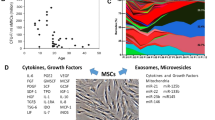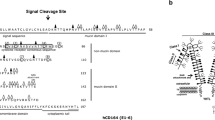Summary:
While bone marrow transplantation has long been established as an effective approach to the clinical management of a variety of malignant and nonmalignant diseases, the future application of pluripotent stem cells in transplant settings promises to deliver this therapy to a much broader range of indications. In this review, I summarize the emerging field of embryonic stem cell biology in the context of potential clinical applications and regulatory issues.
This is a preview of subscription content, access via your institution
Access options
Subscribe to this journal
Receive 12 print issues and online access
$259.00 per year
only $21.58 per issue
Buy this article
- Purchase on Springer Link
- Instant access to full article PDF
Prices may be subject to local taxes which are calculated during checkout

Similar content being viewed by others
References
Ford CE, Hamerton JL, Barnes DWH et al. Cytological identification of radiation-chimeras. Nature 1956; 177: 452–454.
Wright DE, Wagers AJ, Gulati AP et al. Physiological migration of hematopoietic stem and progenitor cells. Science 2001; 294: 1933–1936.
Till JE, McCulloch EA . A direct measurement of the radiation sensitivity of normal mouse bone marrow cells. Radiat Res 1961; 14: 213–222.
Bradley TR, Metcalf D . The growth of mouse bone marrow cells in vitro. Aust J Exp Biol Med Sci 1966; 44: 287–299.
Thean LE, Hodgson GS, Bertoncello I et al. Characterization of megakaryocyte spleen colony-forming units by response to 5-fluorouracil and by unit gravity sedimentation. Blood 1983; 62: 896–901.
Visser JWM, Bauman JGJ, Mulder AH et al. Isolation of murine pluripotent hemopoietic stem cells. J Exp Med 1984; 159: 1576–1590.
Spangrude GJ, Heimfeld S, Weissman IL . Purification and characterization of mouse hematopoietic stem cells. Science 1988; 241: 58–62.
Orlic D, Bodine DM . What defines a pluripotent hematopoietic stem cell (PHSC): will the real PHSC please stand up! Blood 1994; 84: 3991–3994.
Korbling M, Katz RL, Khanna A et al. Hepatocytes and epithelial cells of donor origin in recipients of peripheral-blood stem cells. N Engl J Med 2002; 346: 738–746.
Abkowitz JL . Can human hematopoietic stem cells become skin, gut, or liver cells? N Engl J Med 2002; 346: 770–772.
Lewis R . A stem cell legacy: Leroy Stevens. Scientist 2000; 14: 19.
Stevens LC . Studies on transplantable testicular teratomas of strain 129 mice. J Natl Cancer Inst 1958; 20: 1257–1270.
Mintz B, Illmensee K . Normal genetically mosaic mice produced from malignant teratocarcinoma cells. Proc Natl Acad Sci USA 1975; 72: 3585–3589.
Evans MJ, Kaufman MH . Establishment in culture of pluripotential cells from mouse embryos. Nature 1981; 292: 154–156.
Martin GR . Isolation of a pluripotent cell line from early mouse embryos cultured in medium conditioned by teratocarcinoma stem cells. Proc Natl Acad Sci USA 1981; 78: 7634–7638.
Doetschman T, Gregg RG, Maeda N et al. Targetted correction of a mutant HPRT gene in mouse embryonic stem cells. Nature 1987; 330: 576–578.
Thomas KR, Capecchi MR . Site-directed mutagenesis by gene targeting in mouse embryo-derived stem cells. Cell 1987; 51: 503–512.
Wilmut I, Schnieke AE, McWhir J et al. Viable offspring derived from fetal and adult mammalian cells. Nature 1997; 385: 810–813.
Thomson JA, Itskovitz-Eldor J, Shapiro SS et al. Embryonic stem cell lines derived from human blastocysts. Science 1998; 282: 1145–1147.
Shamblott MJ, Axelman J, Wang S et al. Derivation of pluripotent stem cells from cultured human primordial germ cells. Proc Natl Acad Sci USA 1998; 95: 13726–13731.
Committee on Science, Engineering, and Public Policy. Scientific and Medical Aspects of Human Reproductive Cloning. National Academy Press: Washington, DC, 2002. http://www.nap.edu/catalog/10285.html
Bjornson CR, Rietze RL, Reynolds BA et al. Turning brain into blood: a hematopoietic fate adopted by adult neural stem cells in vivo. Science 1999; 283: 534–537.
Anderson DJ, Gage FH, Weissman IL . Can stem cells cross lineage boundaries? Nature Med 2001; 7: 393–395.
Wurmser AE, Gage FH . Stem cells: cell fusion causes confusion. Nature 2002; 416: 485–487.
Morshead CM, Benveniste P, Iscove NN et al. Hematopoietic competence is a rare property of neural stem cells that may depend on genetic and epigenetic alterations. Nat Med 2002; 8: 268–273.
Department of Health and Human Services. Stem cells: Scientific Progress and Future Research Directions. National Institutes of Health, 2001 http://www.nih.gov/news/stemcell/scireport.htm
Zerhouni E . Stem cell research. Senate Appropriations Subcommittee on Labor. HHS, Education: Washington, DC, 2002 http://www.nih.gov/about/director/092502sctestimony.htm
Author information
Authors and Affiliations
Rights and permissions
About this article
Cite this article
Spangrude, G. When is a stem cell really a stem cell?. Bone Marrow Transplant 32 (Suppl 1), S7–S11 (2003). https://doi.org/10.1038/sj.bmt.1703936
Published:
Issue Date:
DOI: https://doi.org/10.1038/sj.bmt.1703936



